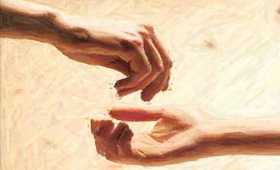Payment of Zaka’at is the third act of worship in Islam. It is a tax which is levied on surplus money, gold, and silver at the rate of two and a half percent annually. Zaka’at means purification of property and increase of goods.
By payment of the Zaka’at tax, the rich in fact deduct a share for the poor from their surplus wealth thus purifying it. The poor, on the other hand, are provided with monetary assistance to help raise their living standard.
It is a beautiful system where the rich get to help the poor, without the poor feeling indebted to the rich. The Zaka’at when due, is given to a central fund and the people who are in charge of distribution, will give it to the poor and needy, as required. Thus the poor and needy are not aware as to who gave them the money, likewise, the rich also do not know where their money went. Therefore, neither feel obliged to the other.
The proceeds of Zaka’at are supposed to be devoted towards:
- relieving poverty and distress
- helping those in debt
- providing comfort and convenience for travellers
- providing stipends for scholarships
- providing ransom for prisoners of war
- propagation of Islam
- meeting the expenses for the collection of Zaka’at
- other things beneficial for the society
Zaka’at, therefore, is a duty enjoined by God in the interest of the society as a whole. While on one hand these charitable contributions provide for the needs for the society, on the other hand, the act of giving in the name of God, purifies the heart of the contributor from selfishness and greed.
There is a second kind of charity in Islam. Besides the obligatory charity of Zaka’at, there is also a voluntary charity called Sadaqah.
Sadaqah can be given by anyone, at anytime, of any amount.
Therefore, even those people who are poor and needy and benefit from the Zaka’at, they also have a way of purifying themselves and giving thanks to Allah through Sadaqah.
Here is a chart explaining what is payable for Zaka’at:-
| Wealth on which Zaka’at is payable | Amount which determines the payment of Zaka’at (Nisab) | Rate of Zaka’at |
| 1. Agricultural produce5 Awsuq (653 kg) per harvest | 5% produce in case of irrigated land; | 10% of produce from rain fed land. |
| 2. Gold, Silver, ornaments of gold and silver | 85 grams of gold or 595 grams of silver | 2.5% of value |
| 3. Cash in bank or in hand | Value of 595 grams of silver | 2.5% of amount |
| 4. Trading Goods | value of 595 grams of silver | 2.5% value of goods |
| 5. Cows & buffaloes30 in number | For every 30, one 1year old; | For every 40, one 2year old. |
| 6. Goats & Sheep40 in number | 1 for first 40, two for 120; | 3 for 300, one more for every 100. |
| 7. Produce of mines | Any quantity | 20% of value of produce |
| 8. Camels | 5 in number | a) upto 24, 1 sheep or goat for each 5 camels; b) 25-35, one 1-year old she camel; c) 36-45, one 2-year old she camel; d) 46-60, one 3-year old she camel; e) 61-75, one 4-year old she camel; f) 76-90, two 2-year old she camel; g) 91-120, two 3-year old she camel; h) 121 or more, one 2-year old she camel for additional 40 or one 3-year old she camel for additional 50. They also give food and rare items to the ones in need. |
Concerning the rates they are:-
Gold or Silver – Nisab (minimum) = 85 grams of Gold or 595 grams of silver - Zaka’at = 2.5% of value. (This includes Jewellery & savings)
Agricultural produce – Nisab = 5 Awsuq (633 kg) per harvest - Zaka’at = 5% produce on irrigated land and 10% produce on rain fed land.
Cows & Buffaloes – Nisab = 30 in number – Zaka’at = for every 30 – one year old; for every 40 – two year old.
Goats & Sheep – Nisab = 40 in number – Zaka’at = 1 for first 40; 2 for 120; 3 for 300 and one more for every 100.

